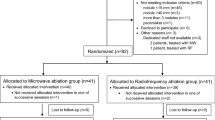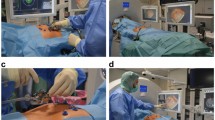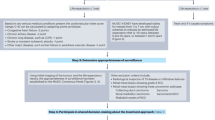Abstract
Improvements in imaging technology have resulted in an increase in detection of small renal masses (SRMs). Minimally invasive ablation modalities, including cryoablation, radiofrequencey ablation, microwave ablation and irreversible electroporation, are currently being used to treat SRMs in select groups of patients. Cryoablation and radiofrequency ablation have been extensively studied. Presently, cryoablation is gaining popularity because the resulting ice ball can be visualized easily using ultrasonography. Tumour size and location are strong predictors of outcome of radiofrequency ablation. One of the main benefits of microwave ablation is that microwaves can propagate through all types of tissue, including desiccated and charred tissue, as well as water vapour, which might be formed during the ablation. Irreversible electroporation has been shown in animal studies to affect only the cell membrane of undesirable target tissues and to spare adjacent structures; however, clinical studies that depict the efficacy and safety of this treatment modality in humans are still sparse. As more experience is gained in the future, ablation modalities might be utilized in all patients with tumours <4 cm in diameter, rather than just as an alternative treatment for high-risk surgical patients.
Key Points
-
Cryoablation has been extensively studied and is gaining popularity because the resulting ice ball can be easily visualized in real time using ultrasonography
-
Radiofrequency ablation relies almost solely on heat conduction to treat solid tumours and is, therefore, most susceptible to heat sinks owing to blood flow
-
Microwaves propagate through all types of tissue, including desiccated and charred, as well as water vapour, which might be formed during the ablation
-
Irreversible electroporation has been shown in animal studies to affect only the cell membrane of undesirable target tissues and to spare adjacent structures
-
In the future, ablation modalities might be utilized in all patients and not just as an alternative treatment for older patients and those considered unfit for surgery
This is a preview of subscription content, access via your institution
Access options
Subscribe to this journal
Receive 12 print issues and online access
$209.00 per year
only $17.42 per issue
Buy this article
- Purchase on Springer Link
- Instant access to full article PDF
Prices may be subject to local taxes which are calculated during checkout
Similar content being viewed by others
References
Chow, W. H., Devesa, S. S., Warren, J. L. & Fraumeni, J. F. Jr. Rising incidence of renal cell cancer in the United States. JAMA 281, 1628–1631 (1999).
Campbell, S. C. et al. Guideline for management of the clinical T1 renal mass. J. Urol. 182, 1271–1279 (2009).
Ljungberg, B. et al. EAU Guidelines on Renal Cell Carcinoma: The 2010 Update. Eur. Urol. 58, 398–406 (2010).
Fergany, A. Current status and advances in nephron-sparing surgery. Clin. Genitourin. Cancer 5, 26–33 (2006).
Uzzo, R. G. & Novick, A. C. Nephron sparing surgery for renal tumors: indications, techniques and outcomes. J. Urol. 166, 6–18 (2001).
Kang, D. C. et al. A systematic review of the quality of evidence of ablative therapy for small renal masses. J. Urol. 187, 44–47 (2012).
Rioja, J., Tzortzis, V., Mamoulakis, C. & Laguna, M. P. Cryotherapy for renal tumors: current status and contemporary developments [Spanish]. Actas Urol. Esp. 34, 309–317 (2010).
Rewcastle, J. C., Sandison, G. A., Saliken, J. C., Donnelly, B. J. & McKinnon, J. G. Considerations during clinical operation of two commercially available cryomachines. J. Surg. Oncol. 71, 106–111 (1999).
Gill, I. S. Renal cryotherapy: pro. Urology 65, 415–418 (2005).
Chosy, S. G., Nakada, S. Y., Lee, F. T. Jr & Warner, T. F. Monitoring renal cryosurgery: predictors of tissue necrosis in swine. J. Urol. 159, 1370–1374 (1998).
Campbell, S. C. et al. Renal cryosurgery: experimental evaluation of treatment parameters. Urology 52, 29–33 (1998).
Graversen, J. A., Mues, A. C. & Landman, J. Laparoscopic ablation of renal neoplasms. J. Endourol. 25, 187–194 (2011).
Schmit, G. D. et al. Percutaneous cryoablation of anterior renal masses: technique, efficacy, and safety. AJR Am. J. Roentgenol. 195, 1418–1422 (2010).
Farrell, M. A. et al. Paranephric water instillation: a technique to prevent bowel injury during percutaneous renal radiofrequency ablation. AJR Am. J. Roentgenol. 181, 1315–1317 (2003).
Cantwell, C. P. et al. Protecting the ureter during radiofrequency ablation of renal cell cancer: a pilot study of retrograde pyeloperfusion with cooled dextrose 5% in water. J. Vasc. Interv. Radiol. 19, 1034–1040 (2008).
Silverman, S. G., Tuncali, K. & Morrison, P. R. MR Imaging-guided percutaneous tumor ablation. Acad. Radiol. 12, 1100–1109 (2005).
Graversen, J. A., Mues, A. C. & Landman, J. Laparoscopic ablation of renal neoplasms. J. Endourol. 25, 187–194 (2011).
Kaouk, J. H., Aron, M., Rewcastle, J. C. & Gill, I. S. Cryotherapy: clinical end points and their experimental foundations. Urology 68, 38–44 (2006).
Tanagho, Y. S. et al. Laparoscopic cryoablation of renal masses: single-center long-term experience. Urology 80, 307–315 (2012).
Guazzoni, G. et al. Oncologic results of laparoscopic renal cryoablation for clinical T1a tumors: 8 years of experience in a single institution. Urology 76, 624–630 (2010).
Faddegon, S. & Cadeddu, J. A. Does renal mass ablation provide adequate long-term oncologic control? Urol. Clin. North Am. 39, 181–190 (2012).
Rodriguez, R., Cizman, Z., Hong, K., Koliatsos, A. & Georgiades, C. Prospective analysis of the safety and efficacy of percutaneous cryoablation for pT1NxMx biopsy-proven renal cell carcinoma. Cardiovasc. Intervent. Radiol. 34, 573–578 (2011).
Spreafico, C. et al. CT-guided percutaneous cryoablation of renal masses in selected patients. Radiol. Med. 117, 593–605 (2012).
Sisul, D. M. et al. RENAL nephrometry score is associated with complications after renal cryoablation: a multicenter analysis. Urology doi:10.1016/j.urology.2012.11.037.
Salas, N., Castle, S. M. & Leveillee, R. J. Radiofrequency ablation for treatment of renal tumors: technological principles and outcomes. Expert Rev. Med. Devices 8, 695–707 (2011).
Bhowmick, P. et al. In vitro assessment of the efficacy of thermal therapy in human benign prostatic hyperplasia. Int. J. Hyperthermia 20, 421–439 (2004).
Bhowmick, S., Coad, J. E., Swanlund, D. J. & Bischof, J. C. In vitro thermal therapy of AT-1 Dunning prostate tumours. Int. J. Hyperthermia 20, 73–92 (2004).
He, X. & Bischof, J. C. The kinetics of thermal injury in human renal carcinoma cells. Ann. Biomed. Eng. 33, 502–510 (2005).
Boss, A., Clasen, S., Kuczyk, M., Schick, F. & Pereira, P. L. Image-guided radiofrequency ablation of renal cell carcinoma. Eur. Radiol. 17, 725–733 (2007).
Leveillee, R. J. & Hoey, M. F. Radiofrequency interstitial tissue ablation: wet electrode. J. Endourol. 17, 563–577 (2003).
Salas, N., Ramanathan, R., Dummett, S. & Leveillee, R. J. Results of radiofrequency kidney tumor ablation: renal function preservation and oncologic efficacy. World J. Urol. 28, 583–591 (2010).
Best, S. L. et al. Long-term outcomes of renal tumor radio frequency ablation stratified by tumor diameter: size matters. J. Urol. 187, 1183–1189 (2012).
Ferakis, N., Bouropoulos, C., Granitsas, T., Mylona, S. & Poulias, I. Long-term results after computed-tomography-guided percutaneous radiofrequency ablation for small renal tumors. J. Endourol. 24, 1909–1913 (2010).
Ji, C. et al. Laparoscopic radiofrequency ablation of renal tumors: 32-month mean follow-up results of 106 patients. Urology 77, 798–802 (2011).
McDougal, W. S., Gervais, D. A., McGovern, F. J. & Mueller, P. R. Long-term followup of patients with renal cell carcinoma treated with radio frequency ablation with curative intent. J. Urol. 174, 61–63 (2005).
Gervais, D. A., McGovern, F. J., Arellano, R. S., McDougal, W. S. & Mueller, P. R. Radiofrequency ablation of renal cell carcinoma: part 1, Indications, results, and role in patient management over a 6-year period and ablation of 100 tumors. AJR Am. J. Roentgenol. 185, 64–71 (2005).
Gervais, D. A., Arellano, R. S. & Mueller, P. Percutaneous ablation of kidney tumors in nonsurgical candidates. Oncology (Williston Park) 19, 6–11 (2005).
Bandi, G., Hedican, S. P. & Nakada, S. Y. Current practice patterns in the use of ablation technology for the management of small renal masses at academic centers in the United States. Urology 71, 113–117 (2008).
Carey, R. I. & Leveillee, R. J. First prize: direct real-time temperature monitoring for laparoscopic and CT-guided radiofrequency ablation of renal tumors between 3 and 5 cm. J. Endourol. 21, 807–813 (2007).
Wingo, M. S. & Leveillee, R. J. Central and deep renal tumors can be effectively ablated: radiofrequency ablation outcomes with fiberoptic peripheral temperature monitoring. J. Endourol. 22, 1261–1267 (2008).
Leveillee, R. J. & Ramanathan, R. Optimization of image-guided targeting in renal focal therapy. J. Endourol. 24, 729–744 (2010).
Ahrar, K. et al. Percutaneous radiofrequency ablation of renal tumors: technique, complications, and outcomes. J. Vasc. Interv. Radiol. 16, 679–688 (2005).
Park, S. et al. Radiofrequency ablation of renal tumors: intermediate-term results. J. Endourol. 20, 569–573 (2006).
Raman, J. D. et al. Renal functional outcomes for tumours in a solitary kidney managed by ablative or extirpative techniques. BJU Int. 105, 496–500 (2010).
Arzola, J., Baughman, S. M., Hernandez, J. & Bishoff, J. T. Computed tomography-guided, resistance-based, percutaneous radiofrequency ablation of renal malignancies under conscious sedation at two years of follow-up. Urology 68, 983–987 (2006).
Hoffmann, R. T. et al. Renal cell carcinoma in patients with a solitary kidney after nephrectomy treated with radiofrequency ablation: mid term results. Eur. J. Radiol. 73, 652–656 (2010).
Zagoria, R. J. et al. Oncologic efficacy of CT-guided percutaneous radiofrequency ablation of renal cell carcinomas. AJR Am. J. Roentgenol. 189, 429–436 (2007).
Carrafiello, G. et al. Percutaneous radiofrequency thermal ablation of renal cell carcinoma: is it possible a day-hospital treatment? Int. J. Surg. 6 (Suppl. 1), S31–S35 (2008).
Su, L. M., Jarrett, T. W., Chan, D. Y., Kavoussi, L. R. & Solomon, S. B. Percutaneous computed tomography-guided radiofrequency ablation of renal masses in high surgical risk patients: preliminary results. Urology 61, 26–33 (2003).
Gupta, A. et al. General anesthesia and contrast-enhanced computed tomography to optimize renal percutaneous radiofrequency ablation: multi-institutional intermediate-term results. J. Endourol. 23, 1099–1105 (2009).
Bird, V. G., Carey, R. I., Ayyathurai, R. & Bird, V. Y. Management of renal masses with laparoscopic-guided radiofrequency ablation versus laparoscopic partial nephrectomy. J. Endourol. 23, 81–88 (2009).
Castle, S., Gorbatiy, V., Salas, N., Karnjanawanichkul, W. & Leveillee, R. Radiofrequency ablation of small renal masses: over 8 year experience at a single institution [abstract]. J. Urol. 185, e613 (2011).
Karam, J. A. et al. Radiofrequency ablation (RFA) of renal tumors: clinical, radiographic, and pathologic results from a tertiary cancer centre. Eur. Urol. Suppl. 9, 246 (2010).
Stern, J. M. et al. Intermediate comparison of partial nephrectomy and radiofrequency ablation for clinical T1a renal tumours. BJU Int. 100, 287–290 (2007).
Moore, C. et al. Effects of microwave ablation of the kidney. J. Endourol. 24, 439–444 (2010).
Muto, G. et al. Laparoscopic microwave ablation and enucleation of small renal masses: preliminary experience. Eur. Urol. 60, 173–176 (2011).
Simon, C. J., Dupuy, D. E. & Mayo-Smith, W. W. Microwave ablation: principles and applications. Radiographics 25 (Suppl. 1), S69–S83 (2005).
Wen, C. C. & Nakada, S. Y. Energy ablative techniques for treatment of small renal tumors. Curr. Opin. Urol. 16, 321–326 (2006).
Ahmed, M., Brace, C. L., Lee, F. T. Jr & Goldberg, S. N. Principles of and advances in percutaneous ablation. Radiology 258, 351–369 (2011).
Brace, C. L. Microwave tissue ablation: biophysics, technology, and applications. Crit. Rev. Biomed. Eng. 38, 65–78 (2010).
Lubner, M. G., Brace, C. L., Hinshaw, J. L. & Lee, F. T. Jr. Microwave tumor ablation: mechanism of action, clinical results, and devices. J. Vasc. Interv. Radiol. 21, S192–S203 (2010).
Hope, W. W. et al. Guidelines for power and time variables for microwave ablation in an in vivo porcine kidney. J. Surg. Res. 153, 263–267 (2009).
Laeseke, P. F., Lee, F. T. Jr, Sampson, L. A., van der Weide, D. W. & Brace, C. L. Microwave ablation versus radiofrequency ablation in the kidney: high-power triaxial antennas create larger ablation zones than similarly sized internally cooled electrodes. J. Vasc. Interv. Radiol. 20, 1224–1229 (2009).
Liang, P. et al. Ultrasound guided percutaneous microwave ablation for small renal cancer: initial experience. J. Urol. 180, 844–848 (2008).
Guan, W. et al. Microwave ablation versus partial nephrectomy for small renal tumors: Intermediate-term results. J. Surg. Oncol. 106, 316–321 (2012).
Clark, P. E., Woodruff, R. D., Zagoria, R. J. & Hall, M. C. Microwave ablation of renal parenchymal tumors before nephrectomy: phase I study. AJR Am. J. Roentgenol. 188, 1212–1214 (2007).
Castle, S. M., Salas, N. & Leveillee, R. J. Initial experience using microwave ablation therapy for renal tumor treatment: 18-month follow-up. Urology 77, 792–797 (2011).
Bai, J. et al. Initial experience with retroperitoneoscopic microwave ablation of clinical T(1a) renal tumors. J. Endourol. 24, 2017–2022 (2010).
Roggan, A. in Laser-Induced Interstitial Thermotherapy (eds Muller, G. & Roggan, A.) 10–44 (SPIE Optical Engineering Press, Bellingham, 1995).
Bown, S. G. Phototherapy in tumors. World J. Surg. 7, 700–709 (1983).
Dick, E. et al. Magnetic resonance imaging-guided laser thermal ablation of renal tumors. BJU Int. 90, 814–822 (2002).
Gettman, M. T. et al. Laparoscopic interstitial laser coagulation of renal tissue with and without hilar occlusion in the porcine model. J. Endourol. 16, 565–570 (2002).
de Jode, M. G., Vale, J. A. & Gedroyc, W. M. MR-guided laser thermoablation of inoperable renal tumors in an open-configuration interventional MR scanner: preliminary clinical experience in three cases. J. Magn. Reson. Imaging 10, 545–549 (1999).
Kariniemi, J., Ojala, R., Hellstrom, P. & Sequeiros, R. B. MRI-guided percutaneous laser ablation of small renal cell carcinoma: Initial clinical experience. Acta Radiol. 51, 467–472 (2010).
Kohrmann, K. U., Vohringer, P., Michel, M. S., Henkel, T. & Alken, P. Durability of laser probes in interstitial thermotherapy: investigations on an ex vivo model of effect of carbonization. J. Endourol. 15, 997–999 (2001).
LaGrange, C. A., Gerber, E. W., Garrett, J. E., Lele, S. M. & Strup, S. E. Interstitial laser ablation of the kidney: acute and chronic porcine study using new-generation diffuser tip fiber. J. Endourol. 21, 1387–1391 (2007).
Lotfi, M. A., McCue, P. & Gomella, L. G. Laparoscopic interstitial contact laser ablation of renal lesions: an experimental model. J. Endourol. 8, 153–156 (1994).
Marberger, M. Ablation of renal tumours with extracorporeal high-intensity focused ultrasound. BJU Int. 99, 1273–1276 (2007).
Marberger, M., Schatzl, G., Cranston, D. & Kennedy, J. E. Extracorporeal ablation of renal tumours with high-intensity focused ultrasound. BJU Int. 95 (Suppl. 2), 52–55 (2005).
Dubinsky, T. J., Cuevas, C., Dighe, M. K., Kolokythas, O. & Hwang, J. H. High-intensity focused ultrasound: current potential and oncologic applications. AJR Am. J. Roentgenol. 190, 191–199 (2008).
Ritchie, R. W. et al. Extracorporeal high intensity focused ultrasound for renal tumours: a 3-year follow-up. BJU Int. 106, 1004–1009 (2010).
Davalos, R. V., Mir, I. L. & Rubinsky, B. Tissue ablation with irreversible electroporation. Ann. Biomed. Eng. 33, 223–231 (2005).
Lee, E. W. et al. Electron microscopic demonstration and evaluation of irreversible electroporation-induced nanopores on hepatocyte membranes. J. Vasc. Interv. Radiol. 23, 107–113 (2012).
Rubinsky, B. Irreversible electroporation in medicine. Technol. Cancer Res. Treat. 6, 255–260 (2007).
Deodhar, A. et al. Renal tissue ablation with irreversible electroporation: preliminary results in a porcine model. Urology 77, 754–760 (2011).
Olweny, E. O. et al. Irreversible electroporation: non-thermal and thermal capabilities for kidney ablation in a porcine model. J. Urol. 187, e344 (2012).
Tracy, C. R., Kabbani, W. & Cadeddu, J. A. Irreversible electroporation (IRE): a novel method for renal tissue ablation. BJU Int. 107, 1982–1987 (2011).
Thomson, K. R. et al. Investigation of the safety of irreversible electroporation in humans. J. Vasc. Interv. Radiol. 22, 611–621 (2011).
Aron, M. et al. Laparoscopic renal cryoablation: 8-year, single surgeon outcomes. J. Urol. 183, 889–895 (2010).
Levinson, A. W. et al. Long-term oncological and overall outcomes of percutaneous radio frequency ablation in high risk surgical patients with a solitary small renal mass. J. Urol. 180, 499–504 (2008).
Takaki, H. et al. Midterm results of radiofrequency ablation versus nephrectomy for T1a renal cell carcinoma. Jpn J. Radiol. 28, 460–468 (2010).
Zagoria, R. J. et al. Long-term outcomes after percutaneous radiofrequency ablation for renal cell carcinoma. Urology 77, 1393–1397 (2011).
Psutka, S. P. et al. Long-term oncologic outcomes after radiofrequency ablation for T1 renal cell carcinoma. Eur. Urol. 63, 486–492 (2013).
Leveillee, R. J. et al. Oncologic outcomes using real-time peripheral thermometry-guided radiofrequency ablation of small renal masses. J. Endourol. 27, 1–10 (2013).
Author information
Authors and Affiliations
Contributions
R. J. Leveillee made substantial contribution to the discussion of content and reviewed the manuscript before submission. All other authors researched data for the article, contributed to discussion of content, wrote the article and reviewed the manuscript before submission.
Corresponding author
Ethics declarations
Competing interests
R. J. Leveillee declares grant/research support (inc. clinical trials) from Covidien and Intio and speakers bureau (honoraria) from Cook Urology and Intuitive Surgical. A. Castro Jr declares grant/research support (inc. clinical trials) from Boston Scientific. The other authors declare no competing interests.
Rights and permissions
About this article
Cite this article
Castro, A., Jenkins, L., Salas, N. et al. Ablative therapies for small renal tumours. Nat Rev Urol 10, 284–291 (2013). https://doi.org/10.1038/nrurol.2013.68
Published:
Issue Date:
DOI: https://doi.org/10.1038/nrurol.2013.68
This article is cited by
-
Treatment for Localized T1a Clear Cell Renal Cell Carcinoma: Survival Benefit for Cryosurgery and Thermal Ablation Compared to Deferred Therapy
CardioVascular and Interventional Radiology (2018)
-
Nephrometry score-guided off-clamp laparoscopic partial nephrectomy: patient selection and short-time functional results
World Journal of Surgical Oncology (2016)
-
First Delayed Resection Findings After Irreversible Electroporation (IRE) of Human Localised Renal Cell Carcinoma (RCC) in the IRENE Pilot Phase 2a Trial
CardioVascular and Interventional Radiology (2016)
-
The application of PADUA scoring system for predicting complications of laparoscopic renal cryoablation
International Urology and Nephrology (2015)
-
Update on Cryoablation for Treatment of Small Renal Mass: Oncologic Control, Renal Function Preservation, and Rate of Complications
Current Urology Reports (2014)



